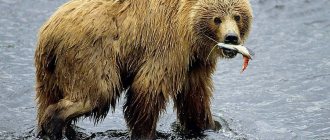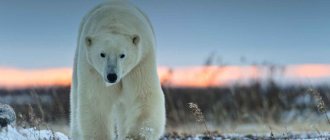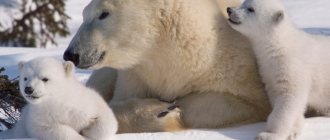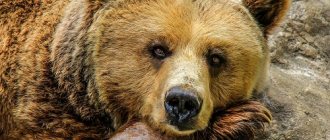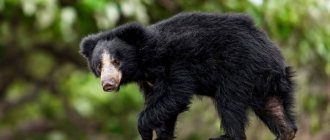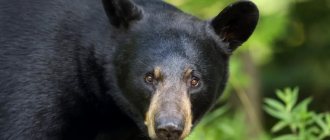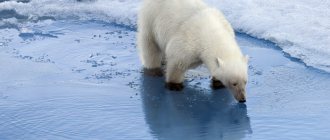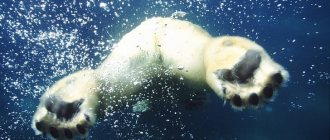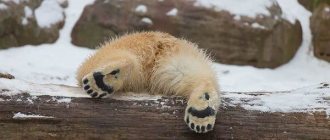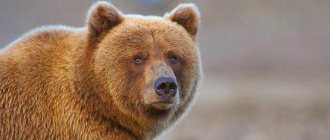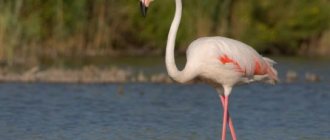- Wild animals
- >>
- Mammals
The giant polar bear is a predatory carnivorous mammal. It was found in ancient times, in the northern coastal regions, and was a very large animal. At a chance meeting he was dangerous. The modern polar bear is a predatory mammal from the bear family. It is a type of brown bear and a direct descendant of a giant prehistoric animal. It remains the largest carnivorous predator on the planet.
Origin of the species and description
Photo: Giant polar bear
The giant polar bear was the name given to a long-extinct subspecies of these animals. These predatory mammals were distinguished by their enormous size (up to 4 m) and heavy weight (up to 1 ton). Researchers have found only a few fragments of this prehistoric animal. His bones were discovered last century in England. The extinction of the species supposedly occurred because there was not enough food to eat under glacial conditions at the end of the Ice Age.
It is believed that the animal was an intermediate link between the usual white and brown species of modern bears. Scientists assumed that more than 100 centuries ago, a white albino animal evolved from an ordinary brown bear. But recently it was proven and scientifically substantiated that the white variety of individuals appeared due to the crossing of the giant and brown subspecies.
In populations of the white variety, up to 10% of the genetics of the giant and 2% of the brown bear were found. This is direct evidence of mixing of species.
The largest predatory animals on the planet
Today there are 8 species of bears living on Earth:
- North American black bear;
- brown;
- polar;
- Asian Black;
- Andean or spectacled;
- panda;
- lazy Bear;
- solar.
Representatives of the species differ in size, weight, habitat and diet. The polar bear is considered the largest on the planet. In second place is the brown one, or more precisely, a subspecies of the brown one - the Kodiak, which lives in Alaska. However, it is very difficult to determine the biggest one in reality.
Appearance and features
Photo: Giant polar bear
The giant polar bear was a very large animal, strong and resilient. He had impressive size and great physical strength. When encountered, the animal could be very dangerous, especially during the rutting period or nursing the cubs. Typically, the body length of the average male individual reached 3.5 m, and the weight was at least a ton. Large males weighed more than 500 kg and had a body length of at least 3 m. Female bears were significantly smaller (200–300 kg, 1.6–2.5 m). The height of the animal to the withers reached 1.7 m.
The polar bear today has a long neck and a small flat head. The color of the coat can be not only white, but with a white-yellowish tint, especially in the warm season.
The fur has a hollow structure, which allows the animal not to freeze in the most severe frosts and not to get wet in icy water. This hairline looks dark in the photo. If an animal spends a long time in a warm climate or in a zoo, its fur may take on a greenish tint, but this is not an indicator of any disease.
The powerful soles of the giant beast's paws were lined with hard, elastic hair, which allowed him to easily move on the slippery icy surface and not freeze in the cold northern climate. A special feature of the polar bear's paws is the membrane between the toes. This allows it to develop great speed in the water and have good maneuverability, despite its external bulk and clumsiness. The beast's huge claws could easily hold small or large prey.
The skeletal system of this large animal had a powerful thickened structure, capable of withstanding great physical stress and the difficult conditions of the northern climate. The giant polar bear is the largest carnivorous mammal that ever lived on earth.
American bogeymen
Once upon a time, grizzlies were a threat to almost the entire North American continent. Its name is translated from Latin as “terrible bear”. Their range is from Alaska to northern Mexico. The Indians considered it a great feat to defeat a grizzly bear. With the arrival of the white man, the extermination of these bears began and now they live only in national parks and protected areas.
Grizzlies are massive animals with long (up to 15 cm) claws that prevent them from climbing trees. Their skin is mostly dark brown, only on the neck and belly it has a lighter shade. The average weight of males is 350-400 kg, body length is 2-2.4 m. Females are about one and a half times smaller. After hibernation, body weight usually decreases; in summer it increases by 20-30%.
Grizzlies have a cool, ferocious disposition. Meeting them does not bode well. Although it is worth noting that only 10% of individuals prefer a meat diet. The rest are content with plant foods and love honey. By the way, all clubfooted animals are immune to bee stings. Grizzlies living near water bodies are excellent fishermen.
Where did the giant polar bear live?
Photo: Giant polar bear
The animal's habitat extended:
- at northern latitudes;
- to modern Newfoundland;
- through the arctic deserts all the way to the tundra.
- Giant polar bears were found on Spitsbergen;
- The largest individuals lived on the coast of the Bering Sea.
On the territory of modern Russia, the habitat of the giant polar bear was the northern coast of the Chukchi Sea, as well as the Arctic and Bering Seas.
Siberian brown bear (weight 750 – 800 kg)
Among the big brown relatives, the Siberian brown bear is the second largest. The body weight of the largest individuals reaches 800 kg, height – 2 m 50 cm. The animal is covered with dark brown fur. Lives in the dense forests of Eastern Siberia, Kazakhstan, Mongolia, and China. The diet of this mammal is 50% plant food, 50% food of animal origin. He is an avid fisherman and prefers shallow waters for fishing. The Siberian bear prefers solitude and spends the winter in a den, where females give birth to cubs.
What did the giant polar bear eat?
Photo: Giant polar bear
The habitat of the polar giant polar bear, like its modern descendant, was fast sea ice and drifting ice floes. Here the animals built their dens, raised their young and caught prey, which included fish, walruses, ringed seals, and sea hares. The carnivorous predatory animal still catches living creatures in an unusual way.
As in ancient times, the animal simply hides in a shelter near the hole and patiently watches for its prey. As soon as the small animal peeks out of the ice hole, the bear quickly stuns it with a blow of its powerful paw and pulls it out of the water to the surface. Bears catch walruses directly on land, where they immediately eat the skin and fat. Bears eat the meat of their prey very rarely, only in very hungry times.
Also, during the hungry period of the year, with a severe lack of food, bears can feed on dead fish, carrion, and algae. Sometimes they do not disdain garbage dumps near polar villages or can destroy a food warehouse, stealing all the provisions from polar explorers.
The largest specimens hunted by humans
Numerous "greatest beasts" in history have their origins in human desires. For example, to appear “cooler” than your fellow tribesmen. For the natives, the story of the hunt for a monster is a kind of moral compensation for the technical superiority of the newcomers. Therefore, there are few reliably documented hunting trophies.
The world record belongs to Roy R. Lindsley, a fisheries conservation officer on Kodiak Island. The man-eating brown bear shot by the man weighed 726 kg. This happened in May 1952 during a scientific expedition to study the Kodiak population. The skull measures 17 15/16 inches long by 12 13/16 inches wide. The catch was declared a world record during the sixth Hunter Club competition, which was held in 1954 at the American Museum of Natural History in New York.
The largest grizzly bear reported by another hunter, Larry Fitzgerald, weighed 980 kg. The man honestly admitted that he did not kill the animal, but only discovered the carcass during a hunt in Alaska in 2013.
Russian fishermen also talk about harvested bears weighing 600+ kg. But the only documentary evidence is the amount of meat handed over at the collection point. Whether it was one animal or 5 small ones, no one knows. Therefore, such information is not taken into account when compiling the top largest hunting trophies.
Features of character and lifestyle
Photo: Giant polar bear
In our time, as in ancient times, the behavior of bears has remained virtually unchanged. Predatory animals in search of food can roam throughout the region depending on the time of year. In the summer they follow the ice closer to the North Pole as fish and seals follow the drifting ice.
In winter, bears travel across the mainland to a depth of 70 km, where they lie down in a den to breed and feed their offspring. Pregnant bears usually hibernate for 3-4 months. Males do not sleep long, about a month, because in winter they hunt and obtain food, storing subcutaneous fat for the hungry period.
The characteristic behavior of male and female individuals depends on the time of year. During the warm period, when there is an abundance of food around, animals behave peacefully and do not attack people or livestock. In the harsh Arctic winter, bears are forced to fight for their survival, so they can be very aggressive and dangerous to people or pets.
Females with cubs are the most dangerous when unexpectedly encountered. Their instinct for preserving offspring is triggered and they immediately attack anyone who dares to approach the den with cubs. All polar bears look rather bulky, clumsy and clumsy. In fact, the animals are very fast and agile both in water and on land.
Features of polar bears:
- a thick layer of subcutaneous fat protects against frost;
- dense wool protects well from freezing in an ice bath;
- White fur is a good camouflage.
The animal is almost impossible to notice against a white background of ice or snow. Thanks to its excellent sense of smell and hearing, the giant ancient predator could smell its prey several hundred meters away. On water, the animal could cover enormous distances and reach speeds of up to 6 km/h. This helped him catch any, even very agile prey. Using a GPS tracker, a case of a polar bear moving at high speed over more than 600 km was recorded. in just a few days.
Predatory individuals, such as giant polar bears, could attack large animals such as seals; today they are also very dangerous. Therefore, in areas where polar bears are abundant, you need to be extremely careful and move very carefully. It is necessary to carefully inspect the surroundings so as not to fall into the den of a female bear or a hungry male connecting rod.
Battle for leadership
As already mentioned, the Guinness Book of Records considers the largest bear to be a white one. But a number of zoologists call the largest Kodiak. Disagreement arises due to the vagueness of the concept of “biggest bear.” The answer depends on what they mean: the longest, heaviest, largest of those caught, killed by hunters.
Gary Brown's Big Bear Almanac states:
So it turns out that, judging by the weight of the heaviest officially registered animal, the leadership seems to belong to the Kodiak, although the average polar bear will exceed its more heat-loving brother in mass. But again, the average Kodiak will be larger in size than the inhabitant of the ice floes. Therefore, scientists cannot give a definite answer to the question of who is the largest bear on the planet.
Social structure and reproduction
Photo: Giant polar bear
Animals lived alone; they did not have a herd principle. Single males are quite peaceful towards each other, but during the mating season there have always been aggressive fights for possession of the female. Adult animals could attack small cubs and devour them during the hungry period of the year.
The males' rut occurred in spring and early summer: from March to June. Several competitors usually sought the female, but victory always went to the strongest and most worthy. Pregnant females dug a den for themselves in the coastal zone, where, in a warm place protected from prying eyes, they gave birth to offspring - 2 or 3 bear cubs.
Giant polar bears were not very fertile. This subspecies of predators had a very low reproductive potential. The female gave birth once every 2-3 years, but not earlier than after 5-8 years. The she-bear went to her den in mid-autumn, in the latent stage of pregnancy, which lasted up to 250 days. The offspring appeared at the end of winter, but the female remained in hibernation until April. Up to several cubs were usually born in a litter. Throughout her life, the female nursed no more than 15 babies.
The newborn baby weighed from 450 to 700 grams. After the birth of the offspring, the mother did not leave the den for 3 months, then the family left their rookery and began traveling throughout the Arctic. Up to 1.5 years, the female completely fed the offspring with her milk and raised the children, teaching them the basics of winter hunting and ice fishing.
Natural enemies of the giant polar bear
Photo: Giant polar bear
The huge and strong animal had no equal in its natural habitat. A sick or wounded animal could be attacked by a seal or killer whale. Small cubs left without maternal protection were often attacked by wolves or even arctic foxes.
Nowadays, the main enemy of the offspring of the giant polar bear is poachers, who, despite the ban, shoot these animals for the sake of beautiful skins and tasty bear meat.
Population and species status
Photo: Giant polar bear
In the harsh northern conditions, giant polar bears lived on average up to 30 years; today, their descendants in captivity can live more than 40 years. When white males are crossed with brown females, they produce hybrids or polar grizzlies. These animals have the strength and endurance of polar bears, and the intelligence and mobility of brown animals.
The population of animals of the bear family today numbers about 25 thousand individuals worldwide, in Russia - up to 7 thousand. In the near future, it is planned to conduct a planned census of polar bears in the Russian Federation, in order to fully record and preserve their total number.
Big panda
Giant panda
Weight - up to 160 kg, length - up to 1.8 meters. One of the cutest animals in the world also belongs to the bear family. But, unlike other bears, the panda prefers a vegetarian menu, 99% of which is bamboo. However, on occasion, the panda will not disdain small animals, bird eggs or insects. For a long time, scientists argued about which family to classify the panda in - the bear family or the raccoon family. However, at the end of the 19th century, the bearish supporters won. They studied the panda's skin and decided that this cute black and white chubby is almost the ancestor of today's bears. And genetic tests confirmed that the panda is not a giant raccoon at all, but a real bear, the closest relative of the spectacled bear.
